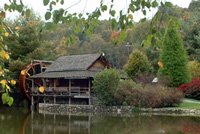
INTRODUCTION
Effective and economical greenhouse heating is the union of an appropriate heat source and an efficient heat distribution system. The best greenhouse heat source in the world is useless if the heat cannot be transferred to the plant environment. Likewise, an efficient heat distribution system is useless if an adequate heat source is not used. The most efficient greenhouse heat source and the most efficient heat distribution system can continue to work well -- only when properly maintained.
LEARNING OBJECTIVES
* Evaluate the strengths and weaknesses of different types of heating systems
* Calculate the heating requirements for a greenhouse.
* Operate greenhouse heating systems in a safe manner.
* List standard maintenance requirements of greenhouse heating systems.
TERMS TO KNOW
greenhouse effect
convection
solar heat
radiant energy
boiler
LP gas
solar energy
perforated polyethylene tubing
natural gas
Btu
horizontal unit heater
central heat
thermostat
a^2 + b^2 = c^2
aspirated thermostat
area of a right triangle = 1/2bh
infiltration
finned pipe
zoned heating
exhaust
unit steam heater
carbon monoxide
heat exchanger
sulfur dioxide
READING ASSIGNMENT
NGMA Heating Tips (75.094 Kb)
1. Read pages 93-159 of the textbook.
2. Read NGMA helpful heating tips (link above3).
ACTIVE LEARNING EXERCISES
1. Watch heating slide show embedded in blog post.
2. Watch the Crossroads Farm (VT) 'Heater Problem' video. Describe what happened to Tim and Janet Taylor when they expanded their greenhouse. (5 pts)
3. Submit use the internet to determine what the record low is for each month where you live (you may need to use a town near you if you live in a rural area). HINT: The Weather Channel has such records available for public viewing. (5 pts)
4. Use the Virtual greenhouse to run the following three simulations (don't adjust any additional settings that will come later):
* Burlington, VT; Winter; double poly, quonset style house, no heater, with set points.
* Burlington, VT; Winter; double poly, quonset style house, 1 heater, with set points.
* Burlington, VT; Winter; double poly, quonset style house, 2 heater, with set points.
Describe what happens in each setting. Make sure you pay close attention to the y-axis on the Air temperature graph. (10 pts)
STUDY QUESTIONS
1. Compare and contrast unit heaters and boilers. Explain the advantages and disadvantages and what types of operations might use both. (10 pts.)
2. Unit heaters are very common with growers who have relatively small amounts of production space. However safety is always an issue. (10 pts)
a. describe the appropriate positioning of the exhaust pipe.
b. why does a grower have to insure a constant source of fresh air when the heater is running.
c. what are two potential byproducts of a poorly functioning heater that are damaging to plants
d. what is a byproduct that can be extremely dangerous to humans
e. What must you do first if you get an alarm in the winter that a heater is off in your ornamental greenhouse?
3. Explain the advantages of an infrared heating system. (5 pts).
4. You have a single a-frame greenhouse with the following dimensions. (You may want to start by drawing yourself a picture). The dimensions are 50 ft (length) X 24 ft (width) X 8 ft (eave height). The ridge is 19 ft high. The glazing material is twin-wall polycarbonate. You want to be able to hold an inside temperature of 55 F even when the temperature outside is 0 F and winds are 20 mph There is no curtain wall. (25 pts)
a. calculate the heat loss/hr (show all your work. HINT: you may want to work through the problem on pages 137-139 STEP-by-STEP. USE THE SAME STEPS FOR THIS PROBLEM. (call me if you have difficulty we will work through it together). If you have difficulty showing the math on Google Documents you can mail me hand written sheets, just make sure they are postmarked by the module due dates.
b. search the internet and locate a unit heater(s) that will supply the amount of heat you calculated. Explain your choice. Don't worry about brand names and cost just BTU output. Please put the website in your answer so that I can check it.
5. You have a gutter connected a-frame (each bay roof) greenhouse with 3 bays and the following dimensions. (You may want to start by drawing yourself a picture). The dimensions are 100 ft (length) X 72 ft (width, each bay is 24 ft in width) X 20 ft (eave height). The ridge at the center of each bay is 26 ft high. You want to be able to hold an inside temperature of 55 F even when the temperature outside is -10 F. The material covering this metal greenhouse is single pane glass. Your greenhouse happens to be located in a very windy area. So count on 35 mph winds on this -10 F winter night you are planning for. (30 pts).
a. calculate the heat loss/hr (show your work)
b. you have decided to have a boiler installed and you will use 2" iron plain pipe (no fins) to deliver the heat to your greenhouse. How many feet of pipe will you need to deliver the amount of heat required on the cold night that you designed the heating system for? How many feet will you need of finned pipe? (see page 79 in your text for a hint).
EXTRAS
I was fascinated by this greenhouse gallery. The ingenuity these people displayed in creating their own local controlled environments was awesome. Most folks were novices. Imagine what you will be able to accomplish once you have successfully completed the course. Imagination + Knowledge = Success


No comments:
Post a Comment